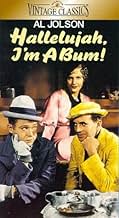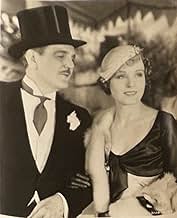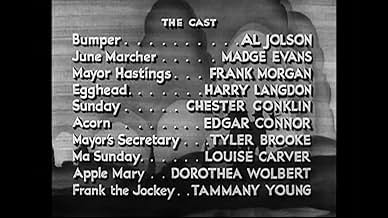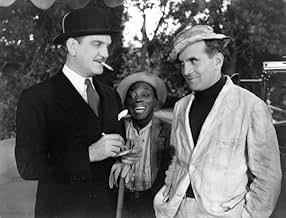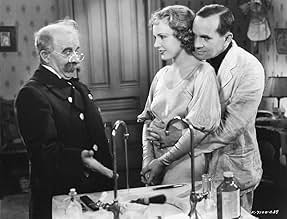Aggiungi una trama nella tua linguaA New York tramp (Jolson) falls in love with the mayor's amnesiac girlfriend after rescuing her from a suicide attemptA New York tramp (Jolson) falls in love with the mayor's amnesiac girlfriend after rescuing her from a suicide attemptA New York tramp (Jolson) falls in love with the mayor's amnesiac girlfriend after rescuing her from a suicide attempt
- Regia
- Sceneggiatura
- Star
Ernie Adams
- Man Thrown out of Apartment Building
- (non citato nei titoli originali)
Vince Barnett
- Assistant
- (non citato nei titoli originali)
Ted Billings
- Bum with Violin
- (non citato nei titoli originali)
Heinie Conklin
- Bum
- (non citato nei titoli originali)
Gino Corrado
- Mayor's Chef
- (non citato nei titoli originali)
John George
- Bum
- (non citato nei titoli originali)
Harold Goodwin
- Len
- (non citato nei titoli originali)
Recensioni in evidenza
I'm not much of a fan of musicals but have always been partial to the stylish, sophisticated and sometimes dazzlingly experimental examples of the genre that emanated during the early years of Talkies - the Lubitsch films, Rouben Mamoulian's LOVE ME TONIGHT (1932) and also the delightful French films of Rene' Clair.
To these I can now add this Al Jolson vehicle directed by one of the great exponents of American cinema (at his best during the 1930s, though he continued to work steadily till 1962). This was only my 3rd Jolson film - not counting THE JOLSON STORY (1946), the first of two biopics made while he was still living!; the others were his history-making debut THE JAZZ SINGER (1927), the pioneering Sound picture, and ROSE OF WASHINGTON SQUARE (1939) - actually, his penultimate film, by which time he had been relegated to supporting roles!
Anyway, the film under review here is something of an oddity in that, not only does it present such humdrum fare as the Great Depression through the eyes of a cheerful tramp and his 'colleagues', but it also makes use of rhyming dialogue (whch in the trailer included on the DVD is ballyhooed as a new fad, but it obviously couldn't last!) which was perhaps intended as a natural lead into the songs; in fact, rather than by official screenwriter S.N. Behrman (adapting a Ben Hecht story), these lines were written by lyricist Lorenz Hart! Unfortunately, however, the print utilized for the MGM/UA DVD is quite battered with the soundtrack coming off rather muffled as a consequence!!
Still, its essential quality remains intact: while the plot may seem dated and even fanciful today (both its romanticized view of unemployment and the hero's eventual decision to 'reform' on account of a woman), atmosphere and characterization are as charming as ever: Jolson, dubbed by his cronies "The Mayor Of Central Park" truly comes off as larger-than-life here, but he's matched by the great Silent comedian Harry Langdon (in his only notable Talkie role) - as one of Jolson's pals, a politically-savvy street-cleaner named Egghead(!) who's picked on by the other tramps because he has a job - and Frank Morgan as the real Mayor of New York (whose life Bumper, the Jolson character, had saved during a protest).
The film also involves a three-way romance between Jolson, Morgan and lovely leading lady Madge Evans: she's the latter's girlfriend but, having incurred his distrust, leaves him intent on committing suicide; she's saved by Jolson and, now an amnesiac, Evans is cared for by him who, in order to pay the rent of her new lodgings, even asks his friend Morgan for a job in a bank!; however, noticing Morgan's own concern about his missing girlfriend, Jolson tries to console him...until he realizes just who she is, after which he decides to re-unite the two of them and himself goes happily back to a life on the streets!
Many films have dealt with the theme of the Great Depression but this one's certainly its most original treatment while also being, along with the marvelous screwball comedy MY MAN GODFREY (1936), one of the very best.
To these I can now add this Al Jolson vehicle directed by one of the great exponents of American cinema (at his best during the 1930s, though he continued to work steadily till 1962). This was only my 3rd Jolson film - not counting THE JOLSON STORY (1946), the first of two biopics made while he was still living!; the others were his history-making debut THE JAZZ SINGER (1927), the pioneering Sound picture, and ROSE OF WASHINGTON SQUARE (1939) - actually, his penultimate film, by which time he had been relegated to supporting roles!
Anyway, the film under review here is something of an oddity in that, not only does it present such humdrum fare as the Great Depression through the eyes of a cheerful tramp and his 'colleagues', but it also makes use of rhyming dialogue (whch in the trailer included on the DVD is ballyhooed as a new fad, but it obviously couldn't last!) which was perhaps intended as a natural lead into the songs; in fact, rather than by official screenwriter S.N. Behrman (adapting a Ben Hecht story), these lines were written by lyricist Lorenz Hart! Unfortunately, however, the print utilized for the MGM/UA DVD is quite battered with the soundtrack coming off rather muffled as a consequence!!
Still, its essential quality remains intact: while the plot may seem dated and even fanciful today (both its romanticized view of unemployment and the hero's eventual decision to 'reform' on account of a woman), atmosphere and characterization are as charming as ever: Jolson, dubbed by his cronies "The Mayor Of Central Park" truly comes off as larger-than-life here, but he's matched by the great Silent comedian Harry Langdon (in his only notable Talkie role) - as one of Jolson's pals, a politically-savvy street-cleaner named Egghead(!) who's picked on by the other tramps because he has a job - and Frank Morgan as the real Mayor of New York (whose life Bumper, the Jolson character, had saved during a protest).
The film also involves a three-way romance between Jolson, Morgan and lovely leading lady Madge Evans: she's the latter's girlfriend but, having incurred his distrust, leaves him intent on committing suicide; she's saved by Jolson and, now an amnesiac, Evans is cared for by him who, in order to pay the rent of her new lodgings, even asks his friend Morgan for a job in a bank!; however, noticing Morgan's own concern about his missing girlfriend, Jolson tries to console him...until he realizes just who she is, after which he decides to re-unite the two of them and himself goes happily back to a life on the streets!
Many films have dealt with the theme of the Great Depression but this one's certainly its most original treatment while also being, along with the marvelous screwball comedy MY MAN GODFREY (1936), one of the very best.
It's hard for most of today's audience to imagine why Al Jolson was once considered the world's greatest entertainer. The well-known clips from THE JAZZ SINGER are more of an embarrassment today than something to be proud of, and he hasn't had much of his recorded legacy in print recently, and what is often tends to be later re-recordings. HALLELUJAH I'M A BUM is one of the best examples of Jolson's charm and wit as a performer and although the film is a quirky period piece, it should be of interest to anyone who appreciates musical theater. While the film features "songs," it also features dialog that is spoken to a beat and to a musical background. It's difficult to describe, but it's charming. Jolson plays Bumper, unofficial "Mayor" of the "bums" of New York. He's accompanied by a short Black sidekick named Acorn played by Edgar Connor, a very talented man (also seen in the infamous "Rufus Jones For President" short with the young Sammy Davis Jr. and Ethel Waters). Other colorful characters include the great Harry Langdon as the Marxist trash collector (his scenes with Jolson are wonderful...I think I read once that his part had been cut down somewhat. A shame the outtakes don't survive), and silent comedy legend Chester Conklin as Sunday, who operates a horse and carriage. Frank Morgan as the mayor of the REAL New York City, and Madge Evans as the mayor's amnesia-suffering girlfriend (whom Jolson saves from drowning herself) represent the "Straight" non-bum world, which Bumper and Acorn briefly join, but cannot find happiness in. I'm don't know a lot about the Rodgers and Hart team, but their songs and dialog are still fresh sounding today, and they created a wonderful vehicle for Al Jolson that, unintentionally, may well be the best documentation of him for the modern viewer. This is NOT a film that you may always be in the mood to watch. I can imagine many viewers catching a little of the romanticized homeless people reciting "Musical dialog" and scratching their heads in confusion. I don't usually like musicals (I bought the film back when it came out on VHS because Harry Langdon was in it), but I was won over by it and I can imagine I'll watch it again in a year or two and show it to friends who are involved in musical theater. Check it out if the above description sounds interesting!
This upbeat depression era musical features Broadway sensation Al Jolson as hobo king Bumper. Living in Central Park he and his followers choose a life of leisure to wage slavery debating it in song and rhyme with among others a Red grounds keeper. Even though he's a confidant of the mayor he prefers his laid back lifestyle to patronage work. One night Bumper saves a woman who throws herself off the Bow Bridge. Stricken with amnesia she takes up with Bumper who falls hard enough for her to get a job. When Bumper's "Angel" get's her memory back things change and Bumper returns to his previous vocation.
By 1933 massive unemployment stretched across the land and I can only imagine what the audience reaction of the time might be regarding a musical that extols the joy of joblessness. Jolson's popularity was on the wane having been supplanted by Bing Crosby but he still had enough draw in his voice to make Hallalueh, I'm a Bum a moneymaker and the flimsy story written with sly subversiveness by Ben Hecht does have a light satiric humor to it.
Edgar Conor as sidekick Acorn and silent film clowns Harry Langdon and Chester Conklin add to the film's amiability while Madge Evans as the amnesiac retains a sinewy seductiveness in an evening gown she wears for days on end. Director Lewis Milestone adds his usual camera movements with a striking tableaux here and there but there is also some sloppy back projection and pedestrian editing that gives the finished product a rushed feel. Overall though Hallalueh, I'm a Bum is an oddly interesting take on tough times featuring a legendary talent in fine form.
By 1933 massive unemployment stretched across the land and I can only imagine what the audience reaction of the time might be regarding a musical that extols the joy of joblessness. Jolson's popularity was on the wane having been supplanted by Bing Crosby but he still had enough draw in his voice to make Hallalueh, I'm a Bum a moneymaker and the flimsy story written with sly subversiveness by Ben Hecht does have a light satiric humor to it.
Edgar Conor as sidekick Acorn and silent film clowns Harry Langdon and Chester Conklin add to the film's amiability while Madge Evans as the amnesiac retains a sinewy seductiveness in an evening gown she wears for days on end. Director Lewis Milestone adds his usual camera movements with a striking tableaux here and there but there is also some sloppy back projection and pedestrian editing that gives the finished product a rushed feel. Overall though Hallalueh, I'm a Bum is an oddly interesting take on tough times featuring a legendary talent in fine form.
Hallelujah, I'm a Bum is the only film Al Jolson did in which he eschewed his blackface completely. He should only have done it earlier and stuck to it.
This film was an experiment in something the producers call "rhyming dialog" Today I think it would be called rap. Audiences didn't really take to it in 1933, but today's audience would probably appreciate it more.
A knowledge of history would help. Until the summer of 1932, New York City had a mayor who was something of a ladies' man whose favorite nightspot was a nightclub right in Central Park. It hasn't been there since the late thirties, Tavern on the Green is a poor substitute. Mayor James J. Walker's favorite dining spot was the Central Park Casino. And many homeless and jobless lived in Central Park in their own makeshift city as the recent film Cinderella Man so aptly demonstrated to today's audience.
Frank Morgan before he became typecast as Mr. Befuddlement is the Mayor of New York. And Al Jolson is the unofficial mayor of Central Park. Through a chain of circumstances they both become involved with the same girl, Madge Evans.
Rodgers and Hart wrote two songs in addition to the rhyming dialog, the title song and You Are Too Beautiful. The latter is a nice romantic ballad that Jolson delivers well. Later on in the 1940s both Bing Crosby and Frank Sinatra had primo versions of this song as well.
In Great Britain the film was released as Hallelujah I'm a Tramp because in the British Isles, the word bum has a different connotation.
It's an enjoyable film today if you can catch it by all means do so.
This film was an experiment in something the producers call "rhyming dialog" Today I think it would be called rap. Audiences didn't really take to it in 1933, but today's audience would probably appreciate it more.
A knowledge of history would help. Until the summer of 1932, New York City had a mayor who was something of a ladies' man whose favorite nightspot was a nightclub right in Central Park. It hasn't been there since the late thirties, Tavern on the Green is a poor substitute. Mayor James J. Walker's favorite dining spot was the Central Park Casino. And many homeless and jobless lived in Central Park in their own makeshift city as the recent film Cinderella Man so aptly demonstrated to today's audience.
Frank Morgan before he became typecast as Mr. Befuddlement is the Mayor of New York. And Al Jolson is the unofficial mayor of Central Park. Through a chain of circumstances they both become involved with the same girl, Madge Evans.
Rodgers and Hart wrote two songs in addition to the rhyming dialog, the title song and You Are Too Beautiful. The latter is a nice romantic ballad that Jolson delivers well. Later on in the 1940s both Bing Crosby and Frank Sinatra had primo versions of this song as well.
In Great Britain the film was released as Hallelujah I'm a Tramp because in the British Isles, the word bum has a different connotation.
It's an enjoyable film today if you can catch it by all means do so.
The idea of rhythmic dialogue seems strange today, but was a short-lived fad in the early 30s (best example is the 3 Stooges first Columbia short: "Woman Haters")It works well in Halleleujah, I'm a Bum, since rhyming is only done in parts of the picture.
This was my first introduction to 30s musicals, and is now released on DVD. The "mistress situation" of the Mayor of New York keeping lovely Madge Evans in an apartment in the same building as his is rather interesting as well. Although a "dud" at the boxoffice in 1933, this picture has developed a cult following over the years. Jolson's starring movie career was over by the late 30's due to his ego, but he still has a major reputation as one of the greatest entertainers in history. This picture is a wonderful example of the wild enthusiasm of Hollywood's early talkie musicals with a moral to the story.
This was my first introduction to 30s musicals, and is now released on DVD. The "mistress situation" of the Mayor of New York keeping lovely Madge Evans in an apartment in the same building as his is rather interesting as well. Although a "dud" at the boxoffice in 1933, this picture has developed a cult following over the years. Jolson's starring movie career was over by the late 30's due to his ego, but he still has a major reputation as one of the greatest entertainers in history. This picture is a wonderful example of the wild enthusiasm of Hollywood's early talkie musicals with a moral to the story.
Lo sapevi?
- QuizHallelujah, I'm a Bum (1933), retitled The Heart of New York, was the first Hollywood feature film to be shown on regularly scheduled USA television. It was broadcast by W2XBS, New York City, on 5 July 1939, two months after their inauguration of regular service which had begun on 30 April 1939 with the opening of the New York World's Fair. It is one of over 200 titles in the list of independent feature films made available for television presentation by Advance Television Pictures announced in Motion Picture Herald 4 April 1942. At this time, television broadcasting was in its infancy, almost totally curtailed by the advent of World War II, and would not continue to develop until 1945-1946.
- BlooperA cameraman's arm is reflected in the partially opened window of the Mayor's limousine when the Mayor meets Bumper at the casino.
- Versioni alternativeA re-dubbed and edited version (for UK release) called "Hallelujah, I'm A Tramp" frequently turns up on television. In this version the soundtrack is momentarily erased whenever the word 'bum' is sung!
- ConnessioniFeatured in The All Talking, All Singing, All Dancing Show (1973)
I più visti
Accedi per valutare e creare un elenco di titoli salvati per ottenere consigli personalizzati
Dettagli
- Data di uscita
- Paese di origine
- Lingua
- Celebre anche come
- Happy-Go-Lucky
- Luoghi delle riprese
- Pacific Palisades, Los Angeles, California, Stati Uniti(Central Park scenes)
- Aziende produttrici
- Vedi altri crediti dell’azienda su IMDbPro
- Tempo di esecuzione
- 1h 22min(82 min)
- Colore
- Proporzioni
- 1.37 : 1
Contribuisci a questa pagina
Suggerisci una modifica o aggiungi i contenuti mancanti



